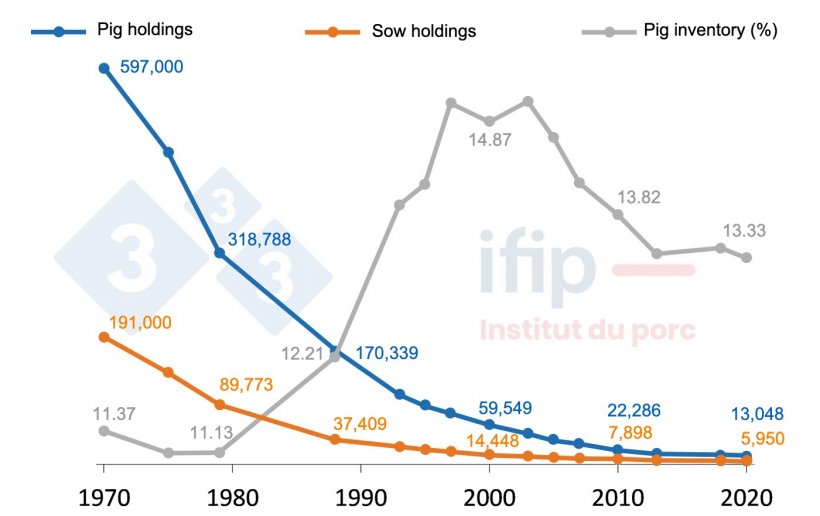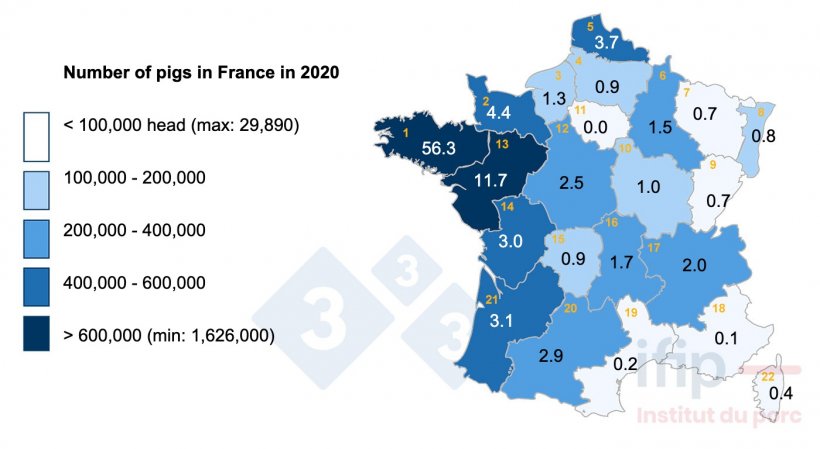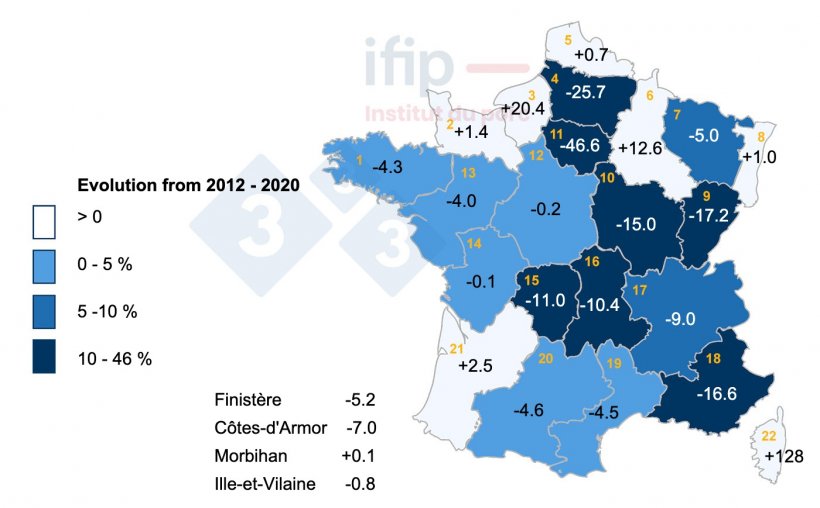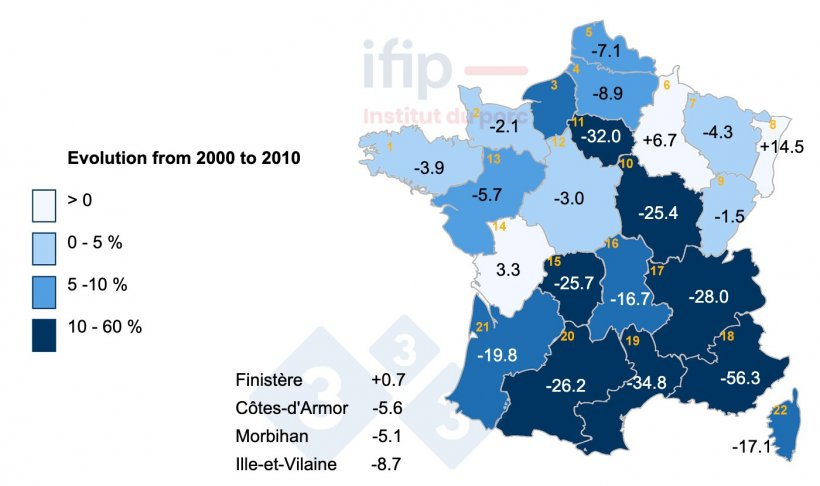Every 10 years, the Agricultural Census provides a snapshot of French agriculture. In 2020, metropolitan France had 389,779 farms (-20% in 10 years). Half of them produced livestock (167,000, -24% in 10 years). Of these, 82% raise herbivores,10% granivores, and 8% are mixed livestock.
The decrease in pig farms is slowing down
The decrease in the number of pig farms is slowing: 59,549 in 2000, 22,286 in 2010 (-63%), and 13,048 in 2020 (-42%). Almost all pigs in the country are raised on a total of 8,448 farms with more than 100 pigs or 20 sows, of which 4,426 have sows. This figure doubled in 2000. The decrease in inventory is also slowing down: 13.3 million pigs in 2020 (-3.5%/2010), including 955,795 sows (-14.3 %).


Evolution of the number of farms with pigs and the number of pigs in France from 1970 to 2020. Source: SSP-Agreste, RGA, RA, ESEA, data processing by IFIP.
Types of pig farms
In France, there are three main types of pig farms: specialized (44% of farms and 67% of pigs); mixed cropping/pig farming (20% of farms and 11% of pigs); mixed herbivore/pig farming (29% of farms and 21% of pigs). All types of pig farms lost farms between 2010 and 2020, but the decrease was greatest for mixed farms with -43.2% farms and -27% pigs while the smallest decrease was for specialty farms with -18.6% farms and +5.9% pigs.
Concentration of the pig inventory
More than 70% of the pig herd is still concentrated in the three western regions of the country (Brittany, Pays de la Loire, and Basse-Normandie). The pig herd held up better outside the Grand Ouest between 2010 and 2020 with only a -2.4% decrease after its 14.2% plunge in the 2000s, while the Grand Ouest lost 4.1% of its pigs. With 56.3% of pigs, Brittany remains France's leading pig farming region, but the drop in the number of pigs there has been greater.

Distribution of the pig inventory in France in 2020. 1 Brittany, 2 Basse-Normandie, 3 Haute-Normandie, 4 Picardie, 5 Nord-Pas-de-Calais, 6 Champagne-Ardenne, 7 Lorraine, 8 Alsace, 9 Franche-Comté, 10 Burgundy, 11 IDF, 12 Centre, 13 Pays de la Loire, 14 Poitou-Charentes, 15 Limousin, 16 Auvergne, 17 Rhône-Alpes, 18 PACA, 19 Languedoc-Roussillon, 20 Midi-Pyrénées, 21 Aquitaine.

Evolution of the pig herd in France (in %) from 2010 to 2020. 1 Brittany, 2 Basse-Normandie, 3 Haute-Normandie, 4 Picardie, 5 Nord-Pas-de-Calais, 6 Champagne-Ardenne, 7 Lorraine, 8 Alsace, 9 Franche-Comté, 10 Burgundy, 11 IDF, 12 Centre, 13 Pays de la Loire, 14 Poitou-Charentes, 15 Limousin, 16 Auvergne, 17 Rhône-Alpes, 18 PACA, 19 Languedoc-Roussillon, 20 Midi-Pyrénées, 21 Aquitaine.

Evolution of the pig herd in France (in %) from 2000 to 2010. 1 Brittany, 2 Basse-Normandie, 3 Haute-Normandie, 4 Picardie, 5 Nord-Pas-de-Calais, 6 Champagne-Ardenne, 7 Lorraine, 8 Alsace, 9 Franche-Comté, 10 Burgundy, 11 IDF, 12 Centre, 13 Pays de la Loire, 14 Poitou-Charentes, 15 Limousin, 16 Auvergne, 17 Rhône-Alpes, 18 PACA, 19 Languedoc-Roussillon, 20 Midi-Pyrénées, 21 Aquitaine.
Most pig farms in France are multi-purpose operations
The pig herd is increasingly concentrated (67% in 2020) on specialized farms with no land and no other animal production, or even no sows. While this reflects the difficulty of managing several livestock units, it also raises the question of separating production units into different legal structures, as does the increase in pig farms without cultivated areas or even without sows. The existence of several legal structures is the result of history, of a regulatory obligation (partnership with a third party, off-farm activity) but often of a choice to obtain authorizations, to adapt to environmental constraints and to the conditionality of aid, to maximize aid, and to optimize tax and social deductions.
Territories specialize more than farms
Farms with crops and livestock production are decreasing in areas oriented around vegetable production (Center, Burgundy, Picardy, etc.) and are progressing in livestock areas with arable land (Brittany). The quest for autonomy on the land, a strategy pig farmers have used since commodity prices skyrocketed in 2008, results in an increase in the average cultivated area per farm, without decreasing the amount of pigs per hectare due to the increase in the number of animals.
Between 2010-2020, the growth in the number of pigs at the two extremes of farm size illustrates the polarization of projects between the creation of small farms (organic, with straw), in short circuits and the development of large conventional farms.
Alternative production and sales are still limited
7.1% of the farms (1.6% of the pig herd) report that some of their pigs are raised outdoors; 5.5% of the farms (1.7% of the pigs) are certified organic or in the process of obtaining the certificate and 8.3% of the farms (3.3% of the pigs) process the meat on the same farm.
The evolution towards increasingly specialized pig production, with little or no land, or other animal production, or even without sows, reflects the difficulty of reconciling several types of production, but also the separation of the productions of an agricultural company into separate legal structures.
The importance of pig production in terms of employment is decreasing, limited to 22,200 full-time equivalents in 2020. Pig farmer succession remains a major issue with one-third of the pigs in the hands of a farmer aged 55 years or older!







